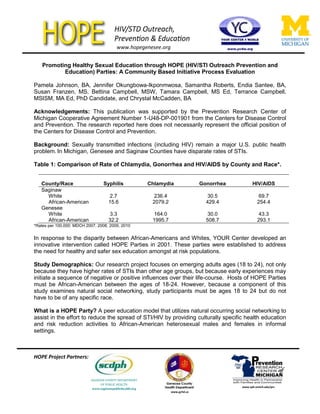
HOPE_handout APHA
- 1. Promoting Healthy Sexual Education through HOPE (HIV/STI Outreach Prevention and Education) Parties: A Community Based Initiative Process Evaluation Pamela Johnson, BA, Jennifer Okungbowa-Ikponmwosa, Samantha Roberts, Endia Santee, BA, Susan Franzen, MS, Bettina Campbell, MSW, Tamara Campbell, MS Ed, Terrance Campbell, MSISM, MA Ed, PhD Candidate, and Chrystal McCadden, BA Acknowledgements: This publication was supported by the Prevention Research Center of Michigan Cooperative Agreement Number 1-U48-DP-001901 from the Centers for Disease Control and Prevention. The research reported here does not necessarily represent the official position of the Centers for Disease Control and Prevention. Background: Sexually transmitted infections (including HIV) remain a major U.S. public health problem. In Michigan, Genesee and Saginaw Counties have disparate rates of STIs. Table 1: Comparison of Rate of Chlamydia, Gonorrhea and HIV/AIDS by County and Race*. County/Race Syphilis Chlamydia Gonorrhea HIV/AIDS Saginaw White 2.7 236.4 30.5 69.7 African-American 15.6 2079.2 429.4 254.4 Genesee White 3.3 164.0 30.0 43.3 African-American 32.2 1995.7 508.7 293.1 *Rates per 100,000: MDCH 2007, 2008, 2009, 2010 In response to the disparity between African-Americans and Whites, YOUR Center developed an innovative intervention called HOPE Parties in 2001. These parties were established to address the need for healthy and safer sex education amongst at risk populations. Study Demographics: Our research project focuses on emerging adults ages (18 to 24), not only because they have higher rates of STIs than other age groups, but because early experiences may initiate a sequence of negative or positive influences over their life-course. Hosts of HOPE Parties must be African-American between the ages of 18-24. However, because a component of this study examines natural social networking, study participants must be ages 18 to 24 but do not have to be of any specific race. What is a HOPE Party? A peer education model that utilizes natural occurring social networking to assist in the effort to reduce the spread of STI/HIV by providing culturally specific health education and risk reduction activities to African-American heterosexual males and females in informal settings. SAGINAW COUNTY DEPARTMENT OF PUBLIC HEALTH www.saginawpublichealth.org www.sph.umich.edu/prc www.gchd.us www.hopegenesee.org www.yc4w.org HOPE Project Partners:
- 2. Process Evaluation: Process evaluation documents and examines the early development and actual implementation of an intervention or program, assessing whether strategies were implemented as planned and whether expected results were actually produced (Bureau of Justice Assistance, 1997). The current process evaluation study examines the results of satisfaction surveys with 181 Hope party participants from Flint and Genesee Counties, Michigan. Results: We noted high satisfaction ratings of the research assistants and of Hope Party staff and activities. Table 2: Means and Standard Deviations of Satisfaction Ratings of Research Assistants*. Variable n Mean (S.D.) The research people treated me with respect. 84 4.40 (.81) The research people helped me understand the consent form. 84 4.43 (.70) The research people answered my questions. 84 4.37 (.77) Table 3: Means and Standard Deviations of Overall Party Satisfaction Ratings*. Variable n Mean (S.D.) These group leaders did a good job facilitating discussion. 181 4.57 (.70) This party increased my knowledge of STI's and HIV. 180 4.56 (.64) I felt comfortable discussing sexuality, STI's and HIV. 181 4.35 (.89) I liked the activities at this party. 181 4.47 (.70) I felt silly at this party. 180 2.22 (1.3) People were really engaged in discussion at this party. 177 4.30 (.80) I felt uncomfortable at this party. 177 2.38 (1.5) I liked discussing healthy sexuality, HIV, and STI's with the group. 177 4.41 (.69) *The mean and standard deviations were based on a rating system where 1=strongly disagree, 2=disagree, 3=neutral, 4=agree and 5=strongly agree. In addition to ratings, participants were asked open ended questions regarding their overall experiences at the party. Common themes were participants “liked everything” about the party and participants enjoyed the educational aspect of the party. In addition, when participants were asked “was there anything you DID NOT like about this party” 96% of participants responded “nothing.” Also, when asked “would you tell other friends to attend a HOPE Party?” 100% of participants that responded answered “yes.” Conclusions: Overall, the design of the HOPE party reports high levels of satisfaction. Possible areas of improvement include increasing comfort levels amongst participants, explanation of the consent form and addressing the participant’s questions. In attempts to improve comfort levels, the researchers propose that a couple of focus groups be conducted with HOPE party participants to identify (a) what is making them uncomfortable and (b) strategies for decreasing the level of discomfort. Also, the researchers propose that the consent form should be explained to participants on an individual basis as opposed to a group setting. This will increase the comfort level of the participant in that the participant can confidentially clarify possible concerns with the research assistant. Though potential improvements have been identified possible areas of improvement are unable to be sufficiently addressed due to the limitations of the current survey tool. Student Contacts: Pamela Johnson: pamelaljohn@gmail.com Jennifer Okungbowa-Ikponmwosa: jokungbo@umflint.edu Samantha Roberts: ssroberts@dow.com Endia Santee: esantee@umflint.edu Your Center Contact: Chrystal McCadden: Chrystal.McCadden@yc4w.org YOUR Center G-3500 Flushing Rd. Suite 220 Flint, MI 48504 810.789.8637 University Contact: Susan Franzen: sfranzen@umich.edu Prevention Research Center of Michigan 400 N. Saginaw St. Suite 201 Flint, MI 810.239.3463